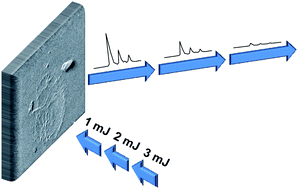Experimental variables and matrix effects associated with the onset of ion generation in laser ionization of solid samples
Abstract
The signal intensity in nanosecond laser ionization of solid samples is the consequence of primary mechanisms resulting from laser-matter interaction, and secondary processes that occurs during free expansion of material in the gas phase. The lower the laser fluence, the less important are the secondary mechanisms. At the minimum energy required—the threshold condition—the onset of ion generation for pure samples depends almost exclusively on their thermal properties. The present paper investigates the influence of some sample variables on the laser-ionization at the threshold conditions with the aim of determining to what extent the differences in ion intensities derived from different matrices does occur from the earliest stages in the ion formation. To perform these studies, different pure (


 Please wait while we load your content...
Please wait while we load your content...